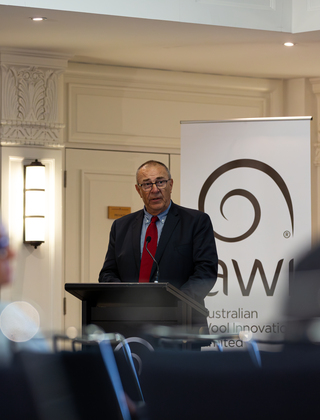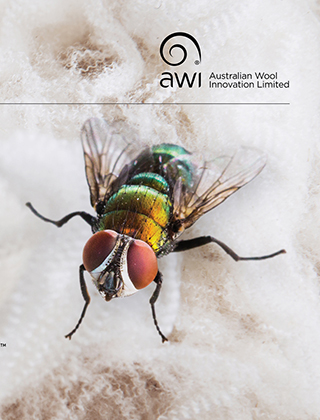AWI Working for Woolgrowers

AWI CEO John Roberts provides readers with an overview of how AWI is undertaking R&D and marketing to address some of the key issues faced by Australian woolgrowers.
AWI investment into wool harvesting solutions for woolgrowers
AWI continues with its multi-pronged approach to make wool harvesting easier and more cost-effective for woolgrowers and the industry. Finding solutions for woolgrowers has been and continues to be a leading priority for AWI.
We have run extra shearing and wool handling courses to draw new entrants into the industry and help retain those already in it. The new Wool Ambassadors Program sees young shearing and wool handling ambassadors in every state promoting the wool harvesting industry. We have also launched a campaign to encourage shearers and wool handlers from overseas to work in Australia during times of peak demand.
AWI continues on work to develop technological options to help with harvesting. These initiatives include the biological wool harvesting project which is progressing well. The AWI sheep delivery module is now commercialised and is being incorporated in more and more sheds across the country.
Woolgrowers can play their part in helping attract and retain workers in the industry by providing modern, professional and safe working conditions on their properties and in their sheds. The SafeSheds self assessment program can help woolgrowers in this regard; the best practice guidelines and checklists not only cover the safety of the shearing shed and machinery but also include work practices, working conditions and staff amenities.
New AWI-funded R&D into suppressing sheep blowfly populations
AWI has recently begun investment in two new projects aimed at reducing the build-up of populations of the Australian sheep blowfly Lucilia cuprina, thereby reducing the incidence of flystrike and woolgrowers’ reliance on chemicals. The first project aims to develop a more effective and potent way of trapping sheep blowflies so that blowfly populations can be suppressed. The second project will release millions of sterile male blowflies on Kangaroo Island in South Australia to see whether it will reduce the blowfly reproduction rate and population. If there is a successful suppression of blowflies on Kangaroo Island, it could indicate that suppression on the mainland might also be possible.
New AWI study backs wool for ‘stop-go’ sports
A recent AWI-funded study into the effectiveness of wool next-to-skin activewear has revealed some exciting results that the company is now using in its marketing to the sports and outdoor industry and consumers to build demand for Australian wool. The study provided the scientific proof that 100% wool base-layer garments (in comparison to other natural and synthetic fabrics) provide greater thermal comfort during outdoor ‘stop-go’ sports, such as hiking, cycling and rock climbing that encompass multiple activity and resting phases. The benefit is most noticeable during the resting phases of these sports when the potential for experiencing ‘after-chill’ is greatest.
Anecdotal evidence has often indicated that base-layers made from wool are more comfortable. However, in the absence of scientific evidence, some sports and outdoor brands have been reluctant to preference wool over other fibre types – hindering potential future demand for wool. With the new laboratory proof to validate wool’s superiority, more brands will hopefully now choose to use the fibre in their products.
The study also suggests that sportspeople who wear 100% wool base-layers have more energy available to devote to their sporting activity, compared to if they wear 100% synthetic or other natural base-layers. This is because wool’s natural thermoregulating qualities mean that less of the sportsperson’s energy is needed to maintain their thermal equilibrium.
AWI joint marketing campaigns with brands and retailers
One of the main ways that AWI’s marketing arm The Woolmark Company directly builds demand for Australian wool is through undertaking marketing collaborations with leading brands and retailers across the world. There are reports in this edition of Beyond the Bale of several such marketing collaborations during the recent Northern Hemisphere peak selling autumn/winter season. A campaign typically aims to, firstly, increase consumers’ awareness of wool’s benefits and put them in a purchase mind-set. Importantly, the campaign then drives and directs customers on a pathway to make wool purchases at retail.
The marketing campaigns can be complex, so to give readers more of an insight into them, we provide an in-depth look at all of the elements of one particular campaign, with iconic retailer Hudson’s Bay in Canada. This successful campaign included a variety of digital and social marketing tactics to drive online customers to a Wool Shop on the Hudson’s Bay e-commerce website, as well as more traditional marketing in the company’s brick-and-mortar stores across Canada.
WoolPoll 2024: investment in industry R&D and marketing
2024 will see woolgrowers vote on what levy rate they collectively pay for research, development, and marketing in WoolPoll 2024. Among the rural research and development corporations (RDCs), AWI is one of two that has a democratic three-yearly vote on what the rate should be. Everyone who has paid $100 in wool levy over the past three years is eligible to vote. Voting can be done online, via the printed ballot paper, or by email and will take place from 20 September until 1 November. Our desire is for growers to make an informed decision about their industry and their RDC, and we encourage them to learn as much as possible through publications like Beyond The Bale.
This article appeared in the March 2024 edition of AWI’s Beyond the Bale magazine. Reproduction of the article is encouraged.















